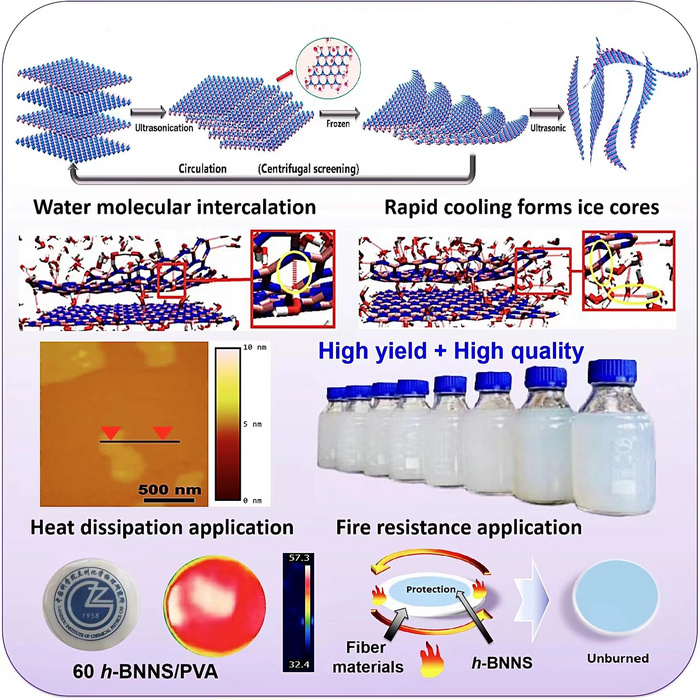Chinese researchers have recently published a paper describing a novel mechanical approach for exfoliating hexagonal boron nitride nanosheets in a controlled manner (h-BNNSs).
 Freezing and ultrasonication assisted exfoliation. Image Credit: Lanzhou Institute of Chemical Physics.
Freezing and ultrasonication assisted exfoliation. Image Credit: Lanzhou Institute of Chemical Physics.
Prof. Junyan Zhang’s group at the Chinese Academy of Sciences (CAS), Lanzhou Institute of Chemical Physics (LICP) devised this technology, which is called the “water-icing triggered exfoliation process.”
High thermal conductivity, good oxidation resistance, superior mechanical strength, exceptional lubricity, excellent biocompatibility, a low dielectric constant, and optical properties are among the chemical and physical properties of h-BNNSs, which have a honeycomb-like structure similar to graphene.
h-BNNSs are attractive materials for a variety of applications, such as high-performance electronic devices, catalysts, thermal management, lubrication, dielectric substrates, sensors, and sorbents, thanks to their features. As a result, there is an urgent need to establish a simple, repeatable, and scalable approach for producing high-quality h-BNNSs for commercial uses.
Zhang and their colleagues presented a scalable and controlled method for exfoliating high-quality h-BNNSs from h-BN flakes in their latest study.
This method relies on efficient reduction of h-BNNS interlayer interaction by rapid volume expansion of water in icing.
Junyan Zhang, Professor, Lanzhou Institute of Chemical Physics, Chinese Academy of Sciences
Chemical vapor deposition (CVD) and physical exfoliation can be used to synthesize h-BNNSs in general. CVD can create wafer-scale, single-crystal monolayer h-BNNSs, whereas physical exfoliation can make small-sized h-BNNSs in a scalable manner.
The researchers hypothesized that -OH groups can create local structural deformation in the defects/edges of h-BN flakes, forming an “entrance” for water molecules entering the h-BNNS interlayer, based on molecular dynamics simulations. As a result, there are enough relatively long-lived hydrogen bonds to create reasonably small initial nuclei for ice nucleation.
The initial nuclei gradually change form and size until they reach a point where they can expand rapidly as the temperature declines. This leads to increased interlayer separation and reduced interlayer tensions between neighboring h-BNNS layers, as well as effective h-BNNS exfoliation during ultrasonication.
By adjusting the parameters, this exfoliation process can be used to produce large quantities of different high-quality h-BNNSs.
Dr. Lulu An, Study First Author, Lanzhou Institute of Chemical Physics, Chinese Academy of Sciences
“This method offers an environmentally friendly method to exfoliate h-BNNSs with controllable thickness by a rapid water freezing and subsequent ultrasonication process. These as-obtained h-BNNSs can be used as polymer additives, thermal conductive fillers, and flame retardants,” Prof. Yuanlie Yu, corresponding author of the research concluded.
The National Natural Science Foundation of China, the Foundation of LICP, CAS, and the Natural Science Foundation of Gansu Province supported this work.
Journal Reference:
An, L., et al. (2022) Water-icing-triggered scalable and controllable exfoliation of hexagonal boron nitride nanosheets. Cell Reports Physical Science. doi.org/10.1016/j.xcrp.2022.100941.